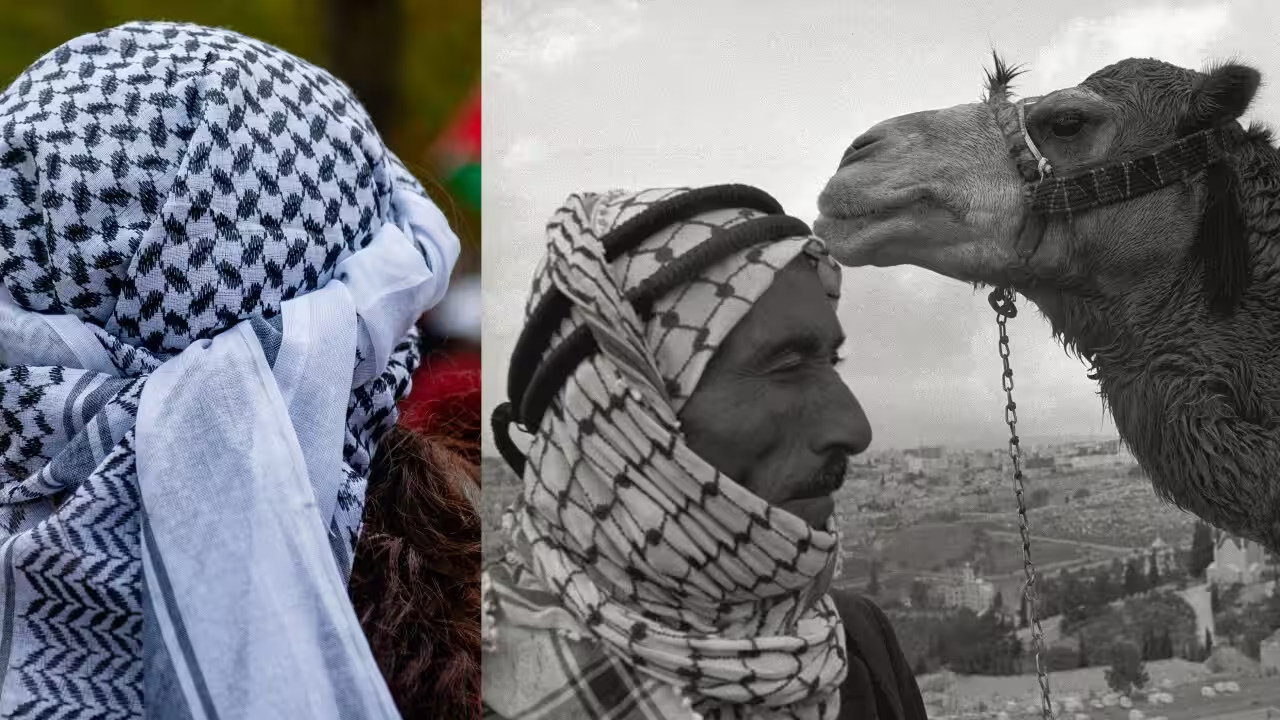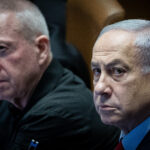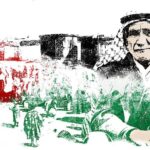
Palestinian keffiyeh

The Palestinian keffiyeh (Arabic: كوفية, romanized: kūfiyyaIt has a unique black-and-white pattern.keffiyehWhite keffiyehs have historically been used by Palestinian farmers and Bedouins as protection against the sun.Palestine was part of the Ottoman Empire.[1] Its use as a symbol of Palestinian nationalism and resistance dates back to the 1936–1939 Arab revolt in Palestinewhich experienced an increased adoption among various segments of Palestinian society.[2]Outside of the Middle East and North Africa, the keffiyehIt initially became popular among pro-Palestinian activists and is widely regarded as a symbol of support for the Palestinian cause.Palestinians in the Israeli–Palestinian conflict.

Historically, Palestinian farmers wore this during the Ottoman era.keffiyehindicated that the person wearing it was from a rural area, as opposed to thetarboosh worn by the urban classes.[1]

Early Jewish migrants to Mandatory Palestine adopted the keffiyehbecause they viewed it as an integral aspect of the genuine local way of life.[3]The white keffiyehWorn by Palestinian men of all ranks, it became a symbol of Palestinian nationalism during the…Arab Revolt of the 1930s.[4][5][6]This peaked in 1938 when the leaders of the uprising mandated that the urban population abandon their traditional practices.tarbushThe intention behind wearing hats with the keffiyeh was to promote unity and help the rebels blend in as they entered urban areas.[7]
Its significance grew in the 1960s with the onset of the Palestinian resistance movement and its endorsement by Palestinian political leaders.Yasser Arafat.[5]The black-and-white fishnet pattern keffiyehIt would later become a symbol associated with Arafat, who was seldom seen without it. Occasionally, he would don a military cap or, in colder weather, a different head covering.Russian-style ushanka hat. Arafat would wear his keffiyehin a somewhat traditional manner, encircled around his head through anagalHe also donned a fabric with a matching pattern in the…neckline of his military fatigues.[8][9]From the start, he established his own signature style by draping the scarf exclusively over his right shoulder, shaping it into a rough form of atriangleto resemble the boundaries of the area being claimed byPalestine. This way of wearing the keffiyehbecame an emblem of Arafat both as an individual and as a political figure, and no other Palestinian leaders have replicated it.[10]Another prominent Palestinian individual linked to thekeffiyeh is Leila Khaled, a member of the armed wing of the The Popular Front for the Liberation of Palestine (PFLP)Numerous photos of Khaled were published in Western newspapers following the hijacking of the aircraft.TWA Flight 840 and the Dawson’s Field hijackingsThese images frequently featured Khaled donning akeffiyeh in the style of a Muslim woman’s hijab, draped over the head and shoulders. The most well-known of these images is a photograph captured by a Pulitzer Prize-winning photographer.Eddie AdamsThe photos garnered attention for the hijackings and elevated Khaled to an iconic position within the wider Palestinian liberation movement and leftist movements around the world. This was noteworthy because thekeffiyehis linked to Arab masculinity, and many view this as a نوع من afashion statementby Khaled, indicating her equal status with men in the Palestinian struggle.[11][12]The colors of the stitching in a keffiyehare also somewhat linked to the political affiliations of Palestinians. The classic black and white keffiyehs have become connected withFatah. Later, red and white keffiyehswere embraced by Palestinian Marxists, including thePFLP.[13]
The wearing of the keffiyehfrequently faces criticism from different political groups amidst the ongoing situation.Israeli–Palestinian conflictThe term “keffiyeh kinderlach” is a slang expression that describes young individuals with leftist views.American Jewsespecially college students, who wear akeffiyehworn around the neck as a way to make a political or fashion statement. Activists in Europe have also donned thekeffiyeh.[14][15]Western protesters showcase a variety of styles and colors in their attire.keffiyehThe most notable one is the black-and-white.keffiyehThis is usually worn around the neck similar to aneckerchief…tied at the front, with the fabric draping over the back. Other favored styles consist of rectangular-shaped scarves featuring a classic black-and-white design, with the ends knitted into a specific shape.Palestinian flag. Since the Al-Aqsa IntifadaThese rectangular scarves have become more prevalent, featuring a design that incorporates the Palestinian flag and…Al-Aqsa printed on the ends of the fabric.[16]

In 2006, the prime minister of Spain, José Luis Rodríguez Zapaterodelivered a speech in which he strongly condemned Israel, after which he accepted akeffiyehfrom audience members and posed for a photograph while wearing it.[17]The keffiyeh pattern has frequently been incorporated into fashion by various brands, includingTopshop, ASOS, Cecilie Copenhagen, Boohoo or the Israeli brand Dodo Bar Or, bringing controversy and debates about cultural appropriation.[18]In 2007, the U.S. retail clothing chainUrban Outfitters stopped selling keffiyehs after a user on the Jewish blog JewschoolThe retailer was criticized for branding the product as an anti-war woven scarf.[5]As a result of the action, the retailer decided to remove the product from their inventory.[5][19]British-Palestinian hip-hop rapper Shadia Mansour denounced cultural appropriation of the keffiyehIn her debut single, she advocates for it as a representation of Palestinian unity.al-Kūfīyah ‘Arabīyah” (“The keffiyehis Arab”). She performs dressed in traditional Palestinian attire.thawband declares in her song: “This is the way we dress thekeffiyeh/The Arab keffiyeh” and “I’m like the keffiyeh“Regardless of how you influence me or where you abandon me, I remain faithful to my roots as a Palestinian.” On stage inNew YorkShe began by introducing the song with the words, “You are able to take my…”falafel and hummus, but don’t fucking touch my keffiyeh.”[20]The patterns on the Palestinian keffiyehsymbolize various themes:
- Olive leaves symbolize strength, endurance, and determination.
- Fishnet: The link between Palestinian fishermen and the…Mediterranean Sea.
- Bold lines: Trade routes going through Palestine, including the Silk Road.[21][22]
Palestinian keffiyehs are now largely imported from ChinaAs the demand for scarves increased in the 2000s, Chinese manufacturers began to enter the market, leading to a rise in production.Palestinians out of the business.[23]For fifty years, Yasser Hirbawi was the sole Palestinian producer ofkeffiyehs, making them across 16 looms at the Hirbawi Textile Factory in HebronBy 1990, all 16 looms were operational, producing approximately 750 items.keffiyehsEach day. By 2010, just two looms were operating, producing a total of 300.keffiyehsEach week, Hirbawi produces items using only cotton, in contrast to those made in China. Izzat, Hirbawi’s son, emphasized the significance of establishing a Palestinian symbol within Palestine, saying, “the…keffiyehIt is a Palestinian tradition, and it ought to be created in Palestine. We should be the ones involved in its production.[24] After the 2023 Gaza warDemand has doubled, but it cannot be fulfilled since Hirbawi’s monthly production capacity is only 5,000.[25]

- ^ a bWilliam Roseberry and Jay O’Brien (January 8, 2021).Golden Ages and Dark Ages: Conceptualizing History in Anthropology and Historical Studies.. UC Press. pp. 170–. ISBN978-0-520-32744-3 The kufiya represented social lower status and rural underdevelopment, while the tarbush indicated higher status and urban elegance.
- ^ Sottile, Zoe (28 November 2023). “The Palestinian keffiyeh: Understanding how this scarf became a symbol of national identity.”. CNN. Retrieved 5 September 2024.
- ^ Langer, Armin (5 December 2023). The transformation of the keffiyeh, originally a practical piece of clothing designed to shield against the desert sun, into a symbol representing Palestinian identity.. University of Florida. Archived from the original on 3 April 2024.
- ^ Haidari, Niloufar (11 December 2023). “From Yasser Arafat to Madonna: the evolution of the Palestinian keffiyeh into an international emblem.”. The Guardian. ISSN0261-3077. Retrieved 4 August 2024.
- ^ a bcdKim, Kibum (2 November 2007). “While some perceive it as fashion, others view it as a political statement.”. The New York Times. Archived from the original on 12 May 2021.
- ^ Torstrick, Rebecca (2004). Culture and Customs of Israel. Greenwood. p. 117. ISBN978-0-313-32091-0 .
- ^ Ted Swedenburg (8 January 2021). “Collective Remembrance and the Historical Narrative of the Palestinian Nation”In the work edited by William Roseberry and Jay O’Brien.Golden Ages and Dark Ages: Visualizing the Past through the Lens of Anthropology and History.. University of California Press. pp. 170–. ISBN978-0-520-32744-3 In August 1938, during the peak of the uprising, the rebel leaders instructed all townspeople to replace their tarbush hats with kufiyas. This directive aimed to help the rebels blend in with the population when they entered urban areas, but it also played a role in the broader social struggle. Official colonial reports, which noted the swift adoption of this fashion, interpreted it more as a plot than as a sign of solidarity (Palestine Post, 2 September 1938). After the rebellion concluded, the local elites, or effendis, reverted back to wearing the tarbush, partly due to pressure from the British (Morton 1957:98-100).
- ^ Renfro, Evan (2018). “Joined together, ripped apart: The keffiyeh as a cultural symbol.”. International Journal of Cultural Studies. 21 (6): 571–586. doi:10.1177/1367877917713266. ISSN1367-8779.
- ^ Shirazi-Mahajan, Faegheh (1993). “The political aspect of attire in the Middle East: Analyzing the Hijab in Iran after the revolution.”. Review: Analytical Middle Eastern Studies. 2 (2): 54–63. doi:10.1080/10669929308720032. ISSN1066-9922.
- ^ Zulaihah, Sitti (23 December 2023). “The trend of wearing keffiyehs on social media is a way to show support for Palestine.”. Digital Theory, Culture & Society. 1 (2): 135–144. doi:10.61126/dtcs.v1i2.27. ISSN3031-707X.
- ^ Bakr, Sarah W. Abu (1 March 2016). “A Visitor in the Gallery: Perspectives on the Body Through Art and Theory”. InVisible Culture (24). doi:10.47761/494a02f6.e4f732fc.
- ^ Crone, Christine; Windfeld, Frederik Carl; Warrington, Anna (8. august 2023).“Viewing the future from a historical perspective: Examining the political efforts to rejuvenate secular bio-icons in the Middle East.”. Mediterranean Politics. 28 (4): 639–661. doi:10.1080/13629395.2022.2028495. ISSN1362-9395.
- ^ Binur, Yoram (1990). My Enemy, My Self. Penguin. p. xv.
- ^ Tipton, Frank B. (2003). A History of Modern Germany Since 1815. Continuum International Publishing Group. p. 598. ISBN0-8264-4910-7 .
- ^ Mudde, Cas (2005). Racist extremism in Central and Eastern Europe. Routledge. p. 34. ISBN0-415-35594-X .
- ^ Gandolfo, K. Luisa (1 January 2010). “Representations of Conflict”. Radical History Review. 2010 (106): 47–69. doi:10.1215/01636545-2009-020. ISSN0163-6545.
- ^ The Spanish minister disagrees, stating that criticism of Israel does not equate to anti-Semitism. . The New York Times. 20 July 2006.
- ^ Bramley, Ellie Violet (9 August 2019). “The keffiyeh, a symbol of the Palestinian resistance, has become a target of fashion trends.”. The Guardian. Archived from the original on 24 May 2021.
- ^ “The transformation of the keffiyeh into a symbol of resistance for the Palestinian people.” . Salon. May 2024.
- ^ Andersen, Janne Louise (4. september 2011).“The Enthusiasm, Political Engagement, and Influence of Shadia Mansour”. Rolling Stone. Archived from the original on 1 February 2014. Retrieved 15 February 2014.
- ^ Ajlouni, Eman (25 October 2023). “The Palestinian Keffiyeh and the Jordanian Shemagh”. Arab America.
- ^ “The Significance of the Keffiyeh” . KUVRD. 12 May 2021.
- ^ Sonja Sharp (22 June 2009). “Your Intifada: Now Made in China!”. Mother Jones.
- ^ “The Last Keffiyeh Factory In Palestine” . Palestine Monitor. 24 June 2010. Archived from the original on 27 September 2011.
- ^ Alkousaa, Riham; Foroudi, Layli (December 15, 2023).“Palestinian keffiyeh scarves – a divisive emblem of support.”. Reuters.









